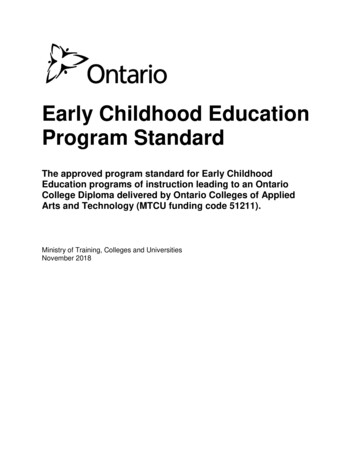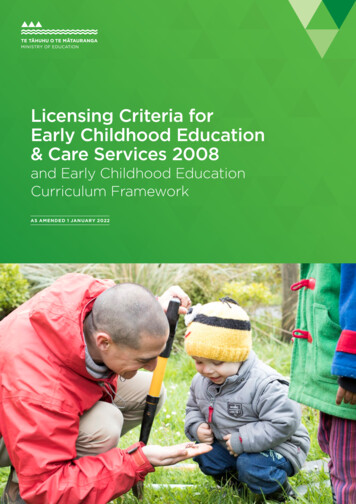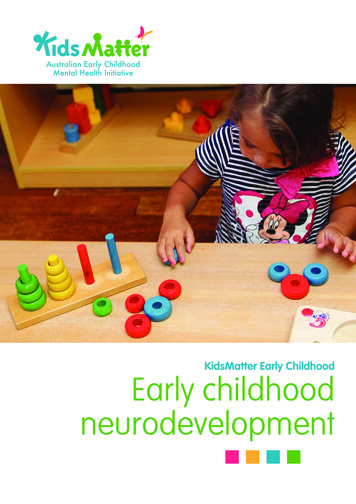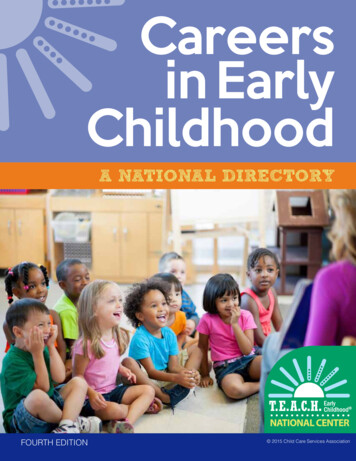
Transcription
MODULE 4 RESOURCE GUIDEQuality Early ChildhoodEnvironments forYoung ChildrenTRAINING FOR EARLY CHILDHOOD CAREGIVERS AND TEACHERS
MODULE 4 RESOURCE GUIDEQuality Early ChildhoodEnvironments for Young ChildrenTRAINING FOR EARLY CHILDHOOD CAREGIVERS AND TEACHERSQUALITY EARLY CHILDHOOD ENVIRONMENTS FOR YOUNG CHILDRENi
This guide is part of a series of manuals that focuses on six topics in EarlyChildhood Development (ECD): different programming approaches, basic concepts,assessments, early childhood environments, children with special needs and childprotection, and the health, safety and nutrition of young children. The series wasprepared within a three-year CRS-led project called “Strengthening the Capacity ofWomen Religious in Early Childhood Development,” or “SCORE ECD.” Fundedby the Conrad N. Hilton Foundation, the project helps Catholic sisters in Kenya,Malawi, and Zambia in their work with children aged 0-5 years and their families.The project is being implemented from January 2014 to December 2016.CRS referred to a wide range of documents in preparing this curriculum. Please see “Reference Documents”section in Module 1 facilitator or resource guide for the full list.Written by Selamawit Tadesse, in cooperation with CRS SCORE ECD team.Edited by David SnyderCover photo: These mothers in Tanzania are showing off the toys and artwork they made using localmaterials as part of a Hilton-supported project that promotes one-on-one interaction between motherand child. Philip Laubner/CRSCopyright 2016 Catholic Relief ServicesAny reproduction, translation, derivation, distribution or other use of this work is prohibited without theexpress permission of Catholic Relief Services (“CRS”). Please obtain permission from pqpublications@crs.org or write to:Catholic Relief Services228 West Lexington StreetBaltimore, MD 21201-3443 USAiiMODULE 4 RESOURCE GUIDE
Table of ContentsRESOURCE GUIDE 4: QUALITY EARLY CHILDHOOD ENVIRONMENT FORYOUNG CHILDREN. 1Purpose.1SESSION 1: THE PHYSICAL ENVIRONMENT . 3Learning objectives.3A safe and healthy environment.3The learning environment.6Arranging the physical environment: Space and learning corners forinfants, toddlers, and pre-schoolers.9Toys and their benefits.30Setting up educational toys in a child friendly space. 32A safe outdoor play environment: What does the playground contain?. 33SESSION TWO: GROUP ACTIVITIES IN EARLY CHILDHOOD ENVIRONMENTS.35Learning objectives. 35What are group times? . 36Why group times are important . 36Morning activity . 38Music and movement . 39Storytelling . 43Field trips .48SESSION 3: PROGRAM PLANNING IN EARLY CHILDHOOD ENVIRONMENTS.53Learning objectives. 53 53Principles of planning . 54A daily program. 54Mixed age groups. 62Team teaching. 62Planning for the year. 63A theme approach. 67Medium-term, weekly, and daily planning . 68QUALITY EARLY CHILDHOOD ENVIRONMENTS FOR YOUNG CHILDRENiii
SESSION 4: SUPPORTING YOUNG CHILDREN IN LANGUAGE AND LITERACY.71Learning objectives. 71 71What is early literacy? . 71How language and literacy develop . 73A print-rich environment . 73Oral language . 74Exploring the sounds of language . 76Storytelling . 77Print awareness and print motivation . 78Reading aloud .80Early writing . 82Partner with parents and caregivers . 83SESSION 5: SUPPORTING YOUNG CHILDREN IN EARLY MATHEMATICS.85Learning objectives. 85 85What is early mathematics? . 85How young children develop mathematical skills . 86Mathematical skills and concepts . 87Mathematical questions. 88Areas of mathematics. 88A mathematics environment. 102Mathematics in the home and community . 103SESSION 6: ADMINISTRATION OF EARLY CHILDHOOD CENTER. 105Learning objectives. 105 105Administration of preschools . 105Financial records . 106Administrative records . 109Educational records .113REFERENCES. 117ivMODULE 4 RESOURCE GUIDE
RESOURCE GUIDE 4: QUALITY EARLY CHILDHOOD ENVIRONMENTS FORYOUNG CHILDRENResource Guide 4 is one of six ECD Resource Guides from the CRS SCORE ECD curriculum.The six series are:1.Approaches to Early Childhood Programs2.Introduction to Early Childhood Development3.Assessing Young Children’s Development4.Quality Early Childhood Environments for Young Children5.Children with Special Needs and Child Protection6.Health, Safety, and NutritionSAMPLE REVIEW“All sisters/congregations and associations in the SCORE ECD project’s countriesfound this curriculum very applicable to their ECD services and programs. Itintegrates spirituality and child development, and it is easily applicable at children’shomes and early childhood centers. Sister congregations/associations of the threecountries worked hard together and contributed to make this curriculum workable.”(Reviewer: Project Coordinator, SCORE ECD, August, 2015)“There is a change in our ECD center because of the knowledge we acquired on howto assess quality ECD environments. Our ECD classroom has really improved withlots of learning and playing corners and activities for even very small children. Wehave come to appreciate locally appropriate educational toys for ECD activities.”(Reviewer: Master Trainer/sister, SCORE ECD, Zambia, August, 2015)“In our training we use our traditional songs for teaching children pre-math and earlyliteracy concepts. It was a good reminder to encourage parents and caregivers touse cultural songs to stimulate their children’s development I have been helped tounderstand that in everything—e.g., water, stones, sticks— there is a concept of mathand literacy.” (Reviewer: Master Trainer/sister, SCORE ECD, Zambia, August, 2015)QUALITY EARLY CHILDHOOD ENVIRONMENTS FOR YOUNG CHILDRENv
Resource Guide 4: QualityEarly Childhood Environmentfor Young ChildrenPURPOSEThe purpose of this guide is to provide information on how caregivers and teacherscan create quality early childhood environments that are safe and secure, healthy, andstimulating for young children’s learning in all areas of their development.This guide is divided into six sessions: Session one provides information on how to create a safe and healthy physicalspace, and places and activities for learning in all areas of development. Ways oforganizing these activities, creating age-appropriate toys from locally availablematerials, and guidelines for adapting materials and activities for children withdisabilities are also introduced. Session two focuses on planning and organizing group times and activities for youngchildren with routines, transitions, movements, field trips, and traditional songs,dances, and stories reflecting the culture of children and their families. Session three focuses on different aspects of planning programs for young childrenthat includes daily schedules and short-term and long-term planning. Session four focuses on how caregivers or teachers can foster young children’searly literacy experiences—speaking, reading, listening, and writing—using everydaylife experiences. Session five focuses on how caregivers or teachers can foster young children’searly mathematical concepts such as numbers, patterns, measurement, shape, andclassification using everyday play activities. Session six focuses on how teachers can manage an early childhood center usingadministrative guidelines and procedures.QUALITY EARLY CHILDHOOD ENVIRONMENTS FOR YOUNG CHILDREN1
Session 1: The PhysicalEnvironmentLEARNING OBJECTIVESBy the end of this session, participants will be able to: Know the attributes of a quality ECD environment by observing an ECD center usingthe environment checklist. Create and organize development and learning activities in different play spaces withadaptation for children with disabilities. Create educational toys using locally available materials.A SAFE AND HEALTHY ENVIRONMENTA well-organized and child-friendly space promotes children’sdevelopment and learning. A quality early childhood physicalenvironment1 is one that: Has space for play activities inside and outside theECD classrooms Has different areas to learn different things (e.g., literacy, art,dramatic play, science, and math) Has playing materials suitable for children’s ages, abilities,and interest Has a planned daily schedule Has a provision for children to feel and build up a senseof communityPriorities in setting up an early childhood environment are: Safety Health A learning environment with lots of developmentally andculturally appropriate opportunities for play, learning, andsocial interactionsA primary consideration in setting up a child-friendly earlychildhood center is safety. This is because young children,especially infants and toddlers, are just exploring their worldand in the process they might hurt themselves unintentionally.Early childhood service providers can ensure safety for youngchildren by creating a safe and supervised environment. Below1IMPORTANT!Early childhood developmentpolicies and guidelines forcreating early childhoodenvironments vary from onecountry to another.The guidelines in this chapterrepresent general practicesrecommended for quality earlychildhood environments. Thesegeneral guidelines can only beeffective when implementedaccording to national/districtguidelines and procedures.For example, programs inKenya, Malawi, and Zambianeed to refer to their respectivenational/district standards whendetermining space, materials,and/or caregiver/child ratio andgroup size when they arrangeearly childhood settings foryoung children.Gonzalez-Mena & Widmeyer Eyer (2012); Kostelnik, Soderman, & Whiren (2007).QUALITY EARLY CHILDHOOD ENVIRONMENTS FOR YOUNG CHILDREN3
are general safety, health, and learning guidelines2 that can help caregivers to monitorthe quality of an early childhood center. The guidelines were adapted from theNational ECD Policy Framework of Kenya (2008) with additional ideas from sourcesindicated in footnotes.NO.24GENERAL GUIDELINE FOR A SAFEENVIRONMENT1.Is the center’s building in good condition and meetsnational standards (e.g., structure is reliable; doorsand windows have locks; indoor space is adequate formovement; chairs and tables are child-sized)?2.Does the center have toilets accessible andappropriate for children, per national guidelines (e.g.,separate for boys and girls; child-sized; clean; waterand soap available)?3.Is there a safety procedure in place for special needschildren per national guidelines (e.g., staff trained onspecial needs; materials and equipment adjusted fortheir use)?4.Are children kept away from places of potentialdanger (e.g., fireplace, electric wires, sockets, kitchen,hot dishes and cooking utensils; electric cord tied toprevent strangling)?5.Is the floor clean, dry, smooth, and free from nails,clips, and other items that can suffocate children?6.Is the national guideline and procedure for emergencyin place (e.g., in case of fire, injury, or illness)?7.Is the indoor and outdoor environment free ofpoisonous plants, vegetation, and objects?8.Are medical materials, cleaning detergents, and sharpobjects such as scissors and knives kept away fromchildren’s reach?9.Are toys safe and appropriate for the age group (e.g.,washable, safe to chew, not too small to be swallowed,not broken or splintered, without toxic paint orsubstance)?10.Are cribs safe for infants (e.g., babies cannot fallthrough or over)?11.Is the food served cut in small sizes, easy to chew, andnutritious?CHECKYesNoCatron & Allen (2008); Gonzalez-Mena & Widmeyer Eyer (2012); Kenya National ECD Policy Framework &ECD Service Standard Guidelines Report by Abagi (2008); Kostelnik, Soderman, & Whiren (2007).MODULE 4 RESOURCE GUIDERemark
HEALTHY ENVIRONMENTNO.GENERAL GUIDELINES FOR A HEALTHYENVIRONMENT1.Does the center have national guidelines andprocedures for health examination and follow up ofchildren (e.g., a health and immunization record keptfor each child, possibly growth monitoring done bytrained staff or in collaboration with the nearest healthcenter)?2.Does the center have national health guidelines inplace for managing injuries, communicable diseases,mild illnesses, preventing the spreading of germs, anddispensing medication for children (including HIVpositive children)?3.Are all medication supplies kept in a safe place, lockedand out of children’s reach?4.Is there parental/caregiver contact information anda consent form for providing medication, informingparents/caregivers, or taking children to clinic/hospitalat the time of emergency?5.Is there a first aid kit with updated information onreferral services near the center or in the community?6.Does the center have staff trained in first aid andcardiopulmonary resuscitation (CPR)?7.Does the center have a resting or sleeping place andfacilities for children?8.Does the center have a regular hand washing routinefor both adults and children to prevent the spreadof germs (e.g., washing hands with running waterand soap before and after meals or toileting; adultswashing hands before and after diaper change)?9.Are there facilities for disposing of trash?10.Does the center follow national health guidelines andprocedures for food preparation (e.g., kitchen is awayfrom learning or diapering area; clean, ventilated, hasfood storage and drying racks, and food is nutritious;cook certified, clean and neat)?11.Does the center have a routine for maintaining thecleanliness of the center (e.g., throwing away trash,cleaning toilets, kitchen, toys, sleeping facilities,diapering and eating areas)?12.Does the center have a good relationship with healthand environmental officers and seek their supportand guidance as a measure of monitoring the center’squality of service for young children?CHECKYesNoRemarkQUALITY EARLY CHILDHOOD ENVIRONMENTS FOR YOUNG CHILDREN5
THE LEARNING ENVIRONMENTIllustration: CRS LesothoGENERAL GUIDELINES FOR THE LEARNINGENVIRONMENT61.Is the caregiver/child ratio arranged per nationalstandards and sufficiently low to promote healthy childdevelopment and attention to all children? (Ask for theratio; for example, for Kenya and Malawi the standardgroup size and ratio for a preschool classroom is 1:35and 1:14 respectively.)2.Does the center have enough space for learning andmovement activities, per national standards for space?3.Does the center have a curriculum with clear goals forsupporting developmentally appropriate and holisticdevelopment of all children in areas of spiritual-moral,large/small motor, self-help, social-emotional, andcognitive-language development?4.Does the learning environment include enough locallyappropriate toys and materials for learning?5.Does the learning environment promote both childcentered and teacher-guided activities (e.g., free-play,small group, and guided learning activities)?6.Do caregivers teach young children variousdevelopmental and self help skills during dailycaregiving routines (e.g., eating, toileting, dressing)?7.Are toys, materials, and equipment provided tochildren appropriate for the child’s age, development,and culture?8.Does the curriculum support children to develop goodself-concept (e.g., teaching about individuality byusing their name, talking about their families, buildinga sense of morality through spiritual counseling,promoting cultural identity)?MODULE 4 RESOURCE GUIDECHECKYesNoRemark
CHECKGENERAL GUIDELINES FOR THE LEARNINGENVIRONMENTYes9.Do caregivers recognize and accept children’s feelingsand encourage appropriate expressions (e.g., whenchild talks to caregiver; when child is upset)?10.Do caregivers treat all children with equal respect(e.g., address the child by name, use polite words, say“please” and “thank you”)?11.Do caregivers promote children’s ability to solve socialproblems by themselves (e.g., allowing children toresolve conflict by themselves when they fight overtoys or space or when they have disagreement)?12.Do caregivers promote desired behavior in childrenusing positive behavior guidance techniques (e.g.,motivate children through praise, reward, modeling,not using physical or verbal punishment, setting clearrules and limits)?13.Do caregivers have an open-door policy that welcomesfamilies to visit the center and exchange their viewsand traditions with caregivers and children (e.g.,caregivers have regular contact with families, respectfamily traditions and child rearing practices)?14.Are caregivers trained for supporting special needschildren such as children with disabilities or gettingsupport from health services when needed?15.Is the learning environment conducive for children withdisabilities (e.g., toilets are adjusted, chairs modified)?16.Do caregivers reach out to families of children withspecial needs and conduct individual learning andintervention plans for the child (e.g., children infectedand affected by HIV and AIDS, or children withdisabilities)?17.Do caregivers conduct regular observation,documentation, and assessment of children’s growthand development, including monitoring their owncare and teaching for quality ECD service (e.g., useassessment record for planning and interventions)?18.Do caregivers respect and maintain confidentialityof all children and families (e.g., protect children’sprivacy; manage disclosure of confidential informationper national guidelines on code of ethics)?19.Do caregivers follow child rights and protectionnational policy in their day-to-day activities withchildren (e.g., absence of physical punishment,verbal abuse, and neglect; advocate for children bydeveloping relationships with concerned communitysupport groups and child protection services)?20.Does the center seek guidance and advice fromearly childhood specialists for improving the qualityof its service for children and families (e.g., updateknowledge and skills in ECD; monitor caregivers’performances and the child’s environment on a regularbasis)?NoRemarkQUALITY EARLY CHILDHOOD ENVIRONMENTS FOR YOUNG CHILDREN7
CLASSROOM DESIGN AND EQUIPMENT REQUIREMENTKenya, Malawi, and Zambia have national standards for classroom design andequipment requirements for classrooms of infants, toddlers, and preschoolers. Forexample, Kenya’s standard for a preschool classroom is 8m x 6m (26 feet by 19feet) (Abagi, 2008). It is recommended that the user of this guide refer to their ownnational standards for this particular information.INCLUSIVE LEARNING ENVIRONMENTS FOR CHILDREN WITH SPECIALDEVELOPMENT AND LEARNING NEEDSIllustration: CRS LesothoGENERAL GUIDELINE FOR AN INCLUSIVE LEARNING ENVIRONMENT3: Environment is inclusive of children affected by HIV and AIDS or children withdisabilities and adapts space and learning activities as fit for their age, abilities,and interests. Caregivers treat children affected by HIV and/or children with disabilities asworthwhile and competent and focus on their strengths, not their limitations. Caregivers encourage interaction of HIV positive children and children withdisabilities with other children by giving them appropriate tasks and responsibilitiesin order to enhance feelings of sameness and acceptance. Caregivers assign and encourage other children to help HIV positive children andchildren with disabilities in group tasks as appropriate to age and abilities of the group. Caregivers design individualized life skill and educational plan (IEP) for vulnerable38CRS, Lesotho (2012); Catron & Allen (2008); Republic of Kenya Ministry of Education (2008).MODULE 4 RESOURCE GUIDE
children (e.g., HIV positive children, orphans) and children with disabilities, adapt theenvironment and make it conducive for their learning (e.g., give children enough timeto complete a given task). Caregivers model inclusive and respectful treatment of vulnerable children (e.g. HIVpositive children, orphans) and children with disabilities by interacting with them thesame way they interact and communicate with other children.CAREGIVER/CHILD RATIOS AND GROUP SIZEA small group size with a sufficiently low caregiver/child ratio is ideal for enhancingchildren’s development. A low ratio provides opportunity for quality interactionbetween the caregiver/children and between children. When setting up an earlychildhood classroom, it is important to consult the national standards for caregiver/child ratio and group size. For example, for Kenya and Malawi the standard group sizeand ratio for a preschool classroom is 1:35 and 1:14 respectively.ARRANGING THE PHYSICAL ENVIRONMENT: SPACE ANDLEARNING CORNERS FOR INFANTS, TODDLERS, AND PRESCHOOLERSYoung children develop and learn about their world (e.g., people, nature, objects)by interacting with people and manipulating and examining objects with their fivesenses. Therefore, it is important that the physical environment supports children’scuriosity to explore, play, and learn. A major consideration is room space, ageappropriate learning materials, and stimulating and positive interactions among andbetween children and adults. Let us see the setting of the rooms and play materialsfor infants, toddlers, and preschoolers4:SPACE FOR INFANTSEating, sleeping, and diapering areas: Have the eating corner near a water sink for washing hands before and after meals; itis also preferable if the kitchen is near the eating area. Have containers of diapers near the diaper changing area, and if possible, use a lowpartition/screen to separate the changing and the learning area. This will allow thecaregiver to change the diaper while supervising other children. Separate the sleeping cots and the play area and use the sleeping area only for restand sleeping. Whenever children are alert and ready to play, use the opportunity tointeract, talk, or sing with them.PLAY AREA FOR INFANTS WITH TOYS AND MATERIALS FOR INSIDE Make the play area spacious enough for infants to crawl, walk, explore, interact, andplay with caregivers or peers comfortably. Space facilitates or hinders development;for example, space encourages infants to move and explore and when they explore, itmeans they are learning. Make the surface of the room as smooth as you can, preferably cemented; this wayyou can easily clean the area after doing messy activities (e.g., water play or handpainting) with infants. You can also play catch ball or serve food on the floor. Provide infants with toys that can stimulate their brain. Stimulating toys includetoys that can make noise when turned, dropped, shaken, or squeezed, toys thathave coarse and smooth texture, toys that are soft and safe to chew on, brightlycolored objects, pictures, books to look at, objects that are moveable and easy topush, pull, or roll.4 Catron & Allen (2008); Dodge, Rudick, & Berke (2011); Petersen & Wittmer (2013).QUALITY EARLY CHILDHOOD ENVIRONMENTS FOR YOUNG CHILDREN9
TODDLERS ARE NEITHER BABIES NOR PRESCHOOLERS!Toddlers are in a unique developmental stage. They are not babies becausethey begin to move and do things by themselves. They are not preschoolersbecause they have not yet developed the mental and physical capacity to sitdown for a fair amount of time and do caregiver-arranged activities. All theywant is to continuously move around and explore! This means caregiversmust provide toddlers with space, materials, and activities that meet theirunique needs. Let them have the chance to move, explore, experiment,discover, and learn!SPACE FOR TODDLERS Provide space for eating, napping, and diapering, including toilets. Arrange child-sized tables and chairs and use them for both eating and learningactivities. Remember to clean up the tables before and after each activity. Put thetables and chairs near the kitchen area for convenience during snack or lunch time. Arrange the eating area near the hand washing and toilet areas so that children canaccess the services easily. It is also convenient for toddlers if the toilet area is nearthe play area. Use the available space for placing cots for nap time; you can do this by moving thetables and chairs temporarily to the corners of the room. Nap time routine is after ameal, therefore use a transition song to prepare toddlers to be ready for naps. Have a corner near the diapering area with shelves to keep toddlers’ clothes.PLAY AREA FOR TODDLERS WITH TOYS AND MATERIALS FOR INSIDERemember toddlers are always moving! Therefore, when you arrange the space,consider allocating the largest space for play and movement. Toddlers have differentplay areas for learning different developmental skills.Circle area: Allocate an open space that allows toddlers toengage in small and individual play and interactions. Thisspace is convenient fo
1 Gonzalez-Mena & Widmeyer Eyer (2012); Kostelnik, Soderman, & Whiren (2007). Session 1: The Physical Environment IMPORTANT! Early childhood development policies and guidelines for creating early childhood environments vary from one country to another. The guidelines in this chapter represent general practices recommended for quality early










